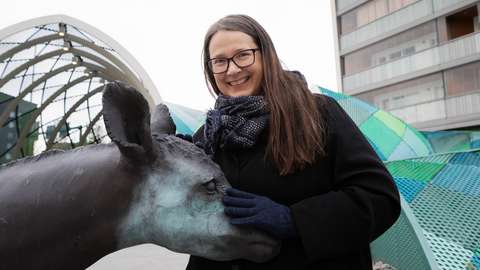Public art enhances urban spaces
Murals on noise barriers, installation art in underpasses or sculptures at metro stations. Art has long been used to enhance the beauty and appeal of urban landscapes. However, public art also serves other purposes.
First, we must define the term ‘public art’.
“In Espoo, public art refers to artworks belonging to our collections and placed in public urban spaces or in various city facilities, such as hospitals, day care centres or offices,” says Henna Paunu, the curator responsible for public art collections at EMMA – Espoo Museum of Modern Art(external link, opens in a new window).
“These works are divided into two categories: commissioned site-specific art created for a particular space or location and works that are on long-term loan from the museum’s collections, such as paintings or sculptures placed in city facilities,” Paunu explains.
The many roles of public art
Public art in urban environments serves several functions. It can, for example, enhance the appeal and safety of the environment and help build a sense of identity. According to Paunu, art is important in itself, but it is often also functional.
“Turning a bleak and empty space into a place where people feel comfortable creates a sense of safety,” she explains.
“In addition to increasing the appeal of a place, artworks can encourage people to use public services, making them more accessible. That is why art has been incorporated into public transport hubs, pedestrian intersections and places like metro stations,” she adds.
Artworks created for new residential areas, in turn, can give the entire area its own distinct character.
“Art is an excellent tool for building a local identity. It can be used to create something personal and unique. It adds a sense of humanity that helps residents connect with their surroundings.”
Environment dictates terms
Site-specific artworks are always created on the terms of their surroundings. Outdoor art is exposed to the elements and wear over time, which must be taken into account in its design and maintenance.
“Artworks must be suitable for their surroundings, safe, maintainable and durable. Each piece has its own maintenance plan or manual according to which it is maintained in collaboration with the Public Works Department,” explains Henna Paunu.
“And from time to time, artworks also require more extensive conservation, for example due to vandalism. Overall, their maintenance needs can vary greatly,” she adds.
Sometimes, the lifespan of an artwork exceeds that of its surroundings. For instance, a mural painted directly on a building’s wall may need to be removed if the building is demolished for one reason or another.
“In such cases, we document the artwork with photographs and preserve its details in that way. Some works can be reproduced, but there are instances where they must be removed entirely if their environment changes and there’s a risk of misuse,” she says.
Choosing artists and artworks requires expertise
The City of Espoo has principles for public art(external link, opens in a new window) (link in Finnish). EMMA becomes involved once the decision to commission an artwork has been made.
“Our role is to provide expert support, find artists suitable for the project and propose them to the project team,” Paunu explains.
Another option for commissioning works would be to organise an art competition where artists submit proposals, allowing the client to choose the most suitable one. However, according to Paunu, Espoo’s current approach has proven effective so far.
“We have a large portfolio of potential artists. In addition, we aim to include younger and lesser-known creators in our projects. In general, artists show great interest in these projects,” she adds.
Commissioning artworks offers artists an excellent opportunity to create site-specific art.
More art for Espoo residents
Espoo has about 800 public artworks, including 60 outdoor installations. The museum continues to work on new public art projects, and more artworks are planned for the near future, according to Paunu.
“Espoo is constantly developing new areas, and public art plays a significant role in defining their character and identity. Ideally, artworks should be included in city construction projects as early as the planning stage, but this is not yet standard practice.”
Can artists express themselves freely when creating commissioned works? Paunu has a clear answer.
“The client expresses their wishes regarding the purpose and use of the artwork, but the final piece represents the artist’s vision created within the given guidelines. Art must always contain an element of surprise. That is the purpose of art.”
